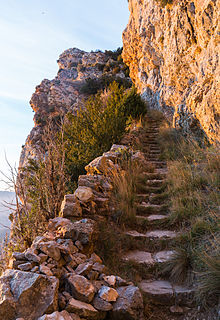Anies
Aniés is a town in the Hoya de Huesca region that belongs to the municipality of La Sotonera in the Province of Huesca. Located between the Riel and Sotón rivers, on a hill at the foot of the mountain range of its name, its distance from Huesca is 27 km.
Demography
| 1970 | 2000 | 2001 | 2002 | 2003 | 2004 |
|---|---|---|---|---|---|
| 236 | 134 | 145 | 142 | 140 | 140 |
History



- From realengo from 1084 to 1158, at least because he was governed by tenants (Ubieto Arteta, Tenants, p. 126)
- In June 1198 King Peter II of Aragon gave to Bishop Ricardo de Huesca the right of patronage over the church of Aniés (Duran, Diplomatic collection of Huesca Cathedral, no. 542)
- In December 1201 García Gudal, bishop of Huesca, gave the order of the Hospital the church of Aniés (Duran, Diplomatic collection of Huesca Cathedral, no. 591)
- In 1566 it was of the order of the Hospital (Duran, A report, p. 295)
- In 1845 he had:
- 114 houses of 10 or 12 high bars
- School of first letters with 40 or 50 disciples
- 3 sources for the assortment of the neighborhood and for the abbreviation of beasts and cattle
- 2 flour mills driving the wheels the waters of the river Riel
- 2 bakery shops, bakery and bread oven for cooking
- 1960 - 1970 joined Bolea, Puibolea, Lierta, Esquedas and Plasencia del Monte to form the Town Hall of La Sotonera.
Monuments
- Parish Church dedicated to San Esteban(photos)
- Hermitage of Nuestra Señora de la Peña (photos)
- Practically hung in the middle of the rocks of the mountain range, next to the house of the healer that has a home, shelves full of old dishes and solo viewpoint
- Chapel of San Cristobal (photos) Archived on January 11, 2007 at Wayback Machine.
- Clavada en losfund de un abismo infernal, entre celdas de eremitas y las aguas claras del naciente río Sotón
- Chapel of Santa Barbara(photos) Archived on 6 December 2006 at Wayback Machine.
- Ermita de San Cosme y San Damián(photos) Archived on 6 December 2006 in Wayback Machine.
To see
- Armier shields
- The Iberian village of Sarrablo.
- Mill of the centuryXIX.
- Fountain and laundry of Fermelar.
- Interesting churches of the centuries XVII-XVIII:
- Casa La Abadía – 1640-, with a geminate vain.
- Casa Cañardo, interesting window with angelotes, soles...
- Home Mainer, cover of large dovelas with registered vegetable elements, very characteristic of the Somontano during the s. XVIII.
- Cross of term at the entrance of the village, very popular.
Society
Social endowment
It has a medical office, swimming pools, a playground, several rural tourism houses, as well as a social club with two meeting rooms, one of them larger and used for popular and private celebrations.
Parties
The patron saint festivities are on August 3 in honor of the patron saint San Esteban, taking advantage of them to coincide with the days closest to the weekend, and on the second Saturday of May in honor of the Virgen de la Peña.
Of the major festivals, in honor of Saint Stephen, it is worth highlighting the Offering of flowers and fruits that takes place on the 3rd and the collection of cakes with their parades and final chocolate.
In the festivities of the second Saturday of May, a pilgrimage is made to the hermitage of the Virgin of La Peña and there they dance at the foot of the hermitage and the hermit's house with a brass band and ham and wine are distributed for all attendees. Afterwards, different groups around the hermitage and surrounding areas prepare the famous lamb stew, ending the day with dancing in the town and a popular dinner, distributing sandwiches to all attendees.
Famous people born in this town
- Augustine Otal - Religious illustrious of the Order of Malta in 1585. He graduated in Canons from the University of Huesca in 1603
- Antonio Pola and Vallés - Religious illustrious of the Order of Malta in 1616
- John of the Church and Urux - Theologian and sacred speaker, who was born in 1683. College of the Major and Royal of Saint Vincent Martyr in 1706, he was a PhD in Theology from the Universidad Sertoriana, of which he was rector in 1727 and a professor at the Prima de Theología. Canon of Jaca and after Huesca, he shined in the sacred oratory, dying in the capital of Altoragon on January 10, 1732. He posted a Panegic prayer in the exequias of King Ntro. Mr. D. Luis I (V. Larumbe, Huesca, 1724).
- Martin Canton and Mincholet - Religious of the Order of Malta and Prior of the Insigne of Chinchilla (Albacete) in 1732
- Domingo Bernués y Lorés - Religious of the Order of Malta and secretary of the Inquisition in Valencia in 1769. Carlos III named him Royal Capellán in that year
Contenido relacionado
Lubumbashi
Province of Heredia
Akranes
General Mosconi (Salta)
Bustantigo